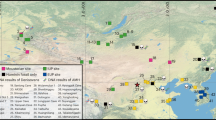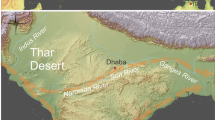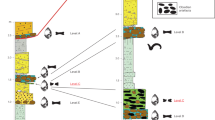Abstract
Well-documented Pliocene archaeological sites are exceptional. At present they are known only in East Africa, in the Hadar1,2 and Shungura3 formations of Ethiopia and in the Nachukui formation of Kenya. Intensive archeological survey and a series of test excavations conducted in the Nachukui formation since 1987 have led to the discovery of more than 25 archaeological sites whose ages range from 2.34 to 0.7 million years before present (Myr)4,5, and to the extensive excavation of two 2.34-Myr sites, Lokalalei 1 in 1991 (refs 6, 7) and Lokalalei 2C in 1997. Lokalalei 2C yielded nearly 3,000 archaeological finds from a context of such good preservation that it was possible to reconstitute more than 60 sets of complementary matching stone artefacts. These refits, predating the Koobi Fora refits by 500 Kyr (ref. 8), are the oldest ever studied. Here we describe a technological analysis of the core reduction sequences, based on these refits, which allows unprecedented accuracy in the understanding of flake production processes. We can thus demonstrate greater cognitive capacity and motor skill than previously assumed for early hominids, and highlight the diversity of Pliocene technical behaviour.
This is a preview of subscription content, access via your institution
Access options
Subscribe to this journal
Receive 51 print issues and online access
$199.00 per year
only $3.90 per issue
Buy this article
- Purchase on Springer Link
- Instant access to full article PDF
Prices may be subject to local taxes which are calculated during checkout




Similar content being viewed by others
References
Roche, H. & Tiercelin, J.-J. in Proc. VIIth Panafrican Congress of Prehistory and Quaternary Studies(eds Leakey, R. E. F. & Ogott, B.) 194–199 (Tilmiap, Nairobi, (1980).
Semaw, S. et al . 2.5-million-year-old stone tool from Gona, Ethiopia. Nature 385, 333–336 (1997).
Howell, F. C., Heasaerts, P. & de Heinzelin, P. Depositional environment, archaeological occurrences and hominids from members E and F of Shungura Formation (Omo Basin, Ethiopia). J. Hum. Evol. 16, 643–664 (1987).
Kibunjia, M., Roche, H., Brown, F. H. & Leakey, R. E. Pliocene and Pleistocene archaeological sites west of Lake Turkana, Kenya. J. Hum. Evol. 23, 431–438 (1992).
Roche, H. & Kibunjia, M. Les sites archéologiques plio-pléistocènes de la Formation de Nachukui, West Turkana, Kenya. Cr. Acad. Sc. Paris 318, 1145–1151 (1994).
Kibunjia, M. Pliocene archaeological occurrences in the lake Turkana Basin, Kenya. J. Hum. Evol. 27, 157–171 (1994).
Kibunjia, M. Archaeological Investigations of Lokalalei 1 (GaJh 5): A Late Pliocene Site, West of Lake Turkana, Kenya.Thesis, Univ. Rutgers(1998).
Isaac, G. Ll. (ed.) Koobi Fora Research Project Vol. 5(Clarendon, Oxford, (1997).
Harris, J. M., Brown, F. H. & Leakey, M. G. Stratigraphy and paleontology of Pliocene and Pleistocene localities west of Lake Turkana, Kenya. Contrib. Sci. 399, 1–128 (1988).
Feibel, C. S., Brown, F. H. & McDougall, I. Stratigraphic context of fossils hominids from the Omo Group deposits, Northern Turkana Basin, Kenya and Ethiopia. Am. J. Phys. Anthropol. 78, 595–662 (1989).
Brown, F. H., McDougall, I., Davis, T. & Maier, R. in Ancestors: The Hard Evidence(ed. Delson, E.) 82–90 (Alan R. Liss, New York, (1985).
Feibel, C. S., Harris, J. M. & Brown, F. H. in Koobi Fora Research Project Vol. 3(ed. Harris, J. M.) 321–370 (Clarendon, Oxford, (1991).
Roche, H. in XIII° Int. Congress of Prehistoric and Protohistoric Sciences, Colloquia Vol. 4, 55–63 (ABACO, Forlì, (1996).
Acknowledgements
We thank the Government of Kenya for permission to carry out this research and the National Museums of Kenya, Meave Leakey and the Kalokol Project for logistical support. The field work was funded by the French Foreign Affairs Ministry (Sous-Direction des Sciences Sociales, Humaines et de l'Archéologie). We thank Total (Kenya) for vehicles and fuel donation, and Crédit Agricole-Indosuez Bank for financial support. The team included J. Ekwiyeni, T. Harkaker, B. K. Kimeu, B. Kimolo, R. M. Kioko, B.Kyongo, E. Lokokodi, S. Mekwea, V. Mugao, K. S. Mulwa, D. Mutinda, A. Mutisya, S. Mutuku, A. Nares, L. K. Ngolokerem, T. Numbe and M. Twaha. We thank J. Feblot-Augustins for her help in translating and editing this paper.
Author information
Authors and Affiliations
Corresponding author
Rights and permissions
About this article
Cite this article
Roche, H., Delagnes, A., Brugal, JP. et al. Early hominid stone tool production and technical skill 2.34 Myr ago in West Turkana, Kenya. Nature 399, 57–60 (1999). https://doi.org/10.1038/19959
Received:
Accepted:
Issue Date:
DOI: https://doi.org/10.1038/19959
This article is cited by
-
The Technological Behaviours of Homo antecessor: Core Management and Reduction Intensity at Gran Dolina-TD6.2 (Atapuerca, Spain)
Journal of Archaeological Method and Theory (2023)
-
Design of tool grinding processes for indexable inserts made of rocks
The International Journal of Advanced Manufacturing Technology (2023)
-
Assessing the subsistence strategies of the earliest North African inhabitants: evidence from the Early Pleistocene site of Ain Boucherit (Algeria)
Archaeological and Anthropological Sciences (2023)
-
Tool wear when using natural rocks as cutting material for the turning of aluminum alloys and plastics
Production Engineering (2023)
-
The Effect of Raw Material on the Identification of Knapping Skill: a Case Study from Olduvai Gorge, Tanzania
Journal of Archaeological Method and Theory (2022)
Comments
By submitting a comment you agree to abide by our Terms and Community Guidelines. If you find something abusive or that does not comply with our terms or guidelines please flag it as inappropriate.



